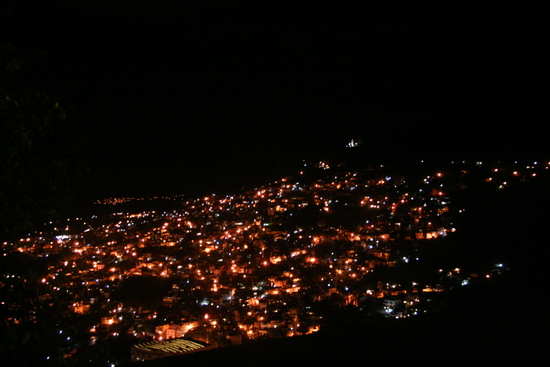Taxco
April 13, 2012 8 Comments
By Rob Packer
Taxco is one of those picture-perfect colonial towns that crop up over Latin America and I visited the town twice while I lived in Mexico in 2010. Unlike a lot of Spanish colonial towns, it isn’t built on a gridiron plan but is instead splashed over a mountainside a few hours south of Mexico City. Streets disappear down canyons or snake around the mountain contours filled with white taxis vochos, the VW Beetle taxis that have mostly disappeared from Mexico City.
Even though I must have been at least 20 before I ever stepped foot in a Beetle, these vochos fill me with a borrowed nostalgia, which blinded me on my second visit with my parents. We got off the bus and they, unused to the altitude of Mexico City, looked at the empty space left by the removed passenger seat (for easy access, luggage or more passengers) and asked me if we’d need two taxis. And I, more used to being wedged in Kyrgyz marshrutki or London tube trains, replied, “Oh no, there’s plenty of room! It’ll be fine!” My face then whitened with terrified responsibility, as we screamed away and tobogganed off a precipitous slope towards our hotel.
Steep slopes and vochos were a constant of that visit and where we had dinner taxistas almost had to back in through the restaurant door to get round a particularly tight bend. This unlikely street plan and location are due to being one of the first silver boom towns in the Americas: mining began early in the Colonial period and the town was founded on top of its silver mine by the conquistador Hernán Cortés. The higgledy-piggledy result is a town that feels like Andalucía with whitewashed houses and red tile roofs, dominated by its main church, the Templo de Santa Prisca. The Baroque façade carved in pink stone of the church is testament to the town’s mineral wealth and especially that of José de la Borda, a silver baron, who had the church built to show gratitude for striking a particularly rich silver vein and was, when he died in 1778, perhaps the richest man in the world.
Today the silver has mostly run out, though the town remains known for its cheap silver products—and there inexplicably does seem to be enough to make particularly vile leopard or gorilla figures (no photos unfortunately) out of the stuff. But for me, it’s just a small, relaxing town to pass a weekend, spending time wandering about the old streets and the zócalo, eating nieves (sorbet) and taking a trip in the cable car or up to the fragrant pine trees and Christ statue at the top of the mountain.














Rob, what a gorgeous post!! Your photographs are amazing. The pink Santa Prisca Church is such a beauty. From top to bottom, I loved the entire series. Bravo! Theadora (Did you spot the old jewelry in brocante-like shops?!)
Thanks! I’m glad you enjoyed it. I did notice some of the jewellery, but can’t remember it all that well (I was a little distracted by the surfing gorilla). Have you been to Taxco, by the way?
Hi Rob! No, I have not been to Taxco. Yet! Thanks to
your post and pics, it’s back on the list! Theadora
Wonderful photos! That church looks like a wedding cake inside–I suppose the decorative motto of the nouveau riche has never been ‘less is more.’ I particularly like all the shots from above, where you can see all the white houses spread out over the hillside.
Thanks! I’m glad you liked it. That church is a wedding cake through and through! The way those houses are spread over the hillside is fantastic: it sometimes feels like you’re in a little village in Andalucía. A magical place.
Certainly. You’ve provided me with another reason to add Mexico to my travel list!
Lovely writing and photos, Rob – what are you up to these days? I see you’re still enjoying photography!
Thanks for the reply, Duncan! I’m glad you liked the post. Yes, I love photography after all these years. I’m working (or will be working) in Brazil to promote nonprofits and develop social businesses in the country. It’s interesting stuff.